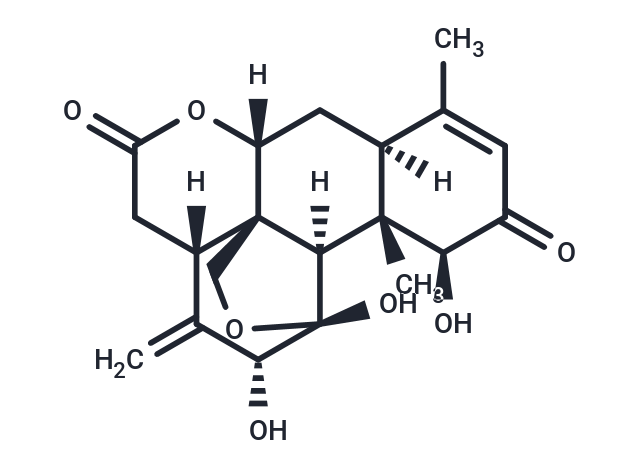Shopping Cart
- Remove All
 Your shopping cart is currently empty
Your shopping cart is currently empty

Ailanthone (AIL) is a natural compound derived from the tree Ailanthus altissima and has anti-hepatocellular carcinoma (HCC) properties. It can induce G0/G1 phase cell cycle arrest by downregulating the expression of cyclins and CDKs, while upregulating the expression of p21 and p27. Additionally, Ailanthone is a potent androgen receptor (AR) inhibitor, capable of inhibiting both the full-length androgen receptor (IC50: 69 nM) and constitutively active splice variants (IC50: 309 nM).

| Pack Size | Price | Availability | Quantity |
|---|---|---|---|
| 1 mg | $36 | In Stock | |
| 5 mg | $80 | In Stock | |
| 10 mg | $118 | In Stock | |
| 25 mg | Preferential | In Stock | |
| 50 mg | Preferential | In Stock | |
| 1 mL x 10 mM (in DMSO) | $89 | In Stock |
| Description | Ailanthone (AIL) is a natural compound derived from the tree Ailanthus altissima and has anti-hepatocellular carcinoma (HCC) properties. It can induce G0/G1 phase cell cycle arrest by downregulating the expression of cyclins and CDKs, while upregulating the expression of p21 and p27. Additionally, Ailanthone is a potent androgen receptor (AR) inhibitor, capable of inhibiting both the full-length androgen receptor (IC50: 69 nM) and constitutively active splice variants (IC50: 309 nM). |
| Targets&IC50 | Androgen receptor:69 nM |
| In vitro | Ailanthone binds to the co-chaperone protein p23 and prevents AR's interaction with HSP90, thus resulting in the disruption of the AR-chaperone complex followed by ubiquitin/proteasome-mediated degradation of AR as well as other p23 clients including AKT and Cdk4, and downregulates AR and its target genes in PCa cell lines and orthotopic animal tumors. In addition, Ailanthone blocks tumor growth and metastasis of CRPC [1]. Ailanthone has been shown to possess a growth-inhibitory effect against several cancer cell lines including R-HepG2, Jurkat, HeLa, HepG2, Hep3B, MCF-7, MDA-MB-231, and A549 cells. Ailanthone inhibits Huh7 cell growth through the induction of mitochondrion-mediated cell apoptosis and G0/G1 cell cycle arrest. Ailanthone-induced apoptosis is mitochondrion-mediated and involved the PI3K/AKT signaling pathway in Huh7 cells [2]. |
| In vivo | Ailanthone (i.p. or p.o.) has excellent efficiency for blocking the growth of CRPC xenografts. In pharmacokinetic studies, Ailanthone exhibits good solubility in water and good bioavailability (>20%). In addition, Ailanthone effectively suppresses CRPC tumor growth, despite not reaching a steady state of plasma drug concentration during the course of treatment [1]. |
| Cell Research | For SRB assay, cells are cultured in complete RPMI 1640 and incubated with indicated concentrations of Ailanthone or cells are maintained in fresh phenol red-free RPMI 1640 medium with 5% charcoal-stripped FBS, 1?nM DHT and indicated compounds. After 48 or 72?h, the cells are then fixed and the cell growth is detected with the SRB assay. For colony formation assay, prostate cancer cells are incubated with indicated concentrations of Ailanthone in complete RPMI 1640 for 2 weeks and then cells are fixed with 4% paraformaldehyde and stained with crystal violet. Colonies are visualized under a microscope, and all of the fields are imaged and counted. Colony formation as a percentage of vehicle control for each cell line is presented [1]. |
| Animal Research | In the orthotopic castration-resistant prostate cancer xenografts model, mice are intraperitoneally injected with Ailanthone (2?mg/kg), MDV (10 mg/kg) or DMSO (as controls). Prostate tumor growth and local metastasis are monitored weekly using the IVIS Imaging System. Images and measurements of bioluminescent signals are acquired and analyzed using software [1]. |
| Alias | Δ13-Dehydrochaparrinone |
| Molecular Weight | 376.4 |
| Formula | C20H24O7 |
| Cas No. | 981-15-7 |
| Smiles | [H][C@]12[C@@]3(O)OC[C@@]11[C@@]([H])(C[C@@]4([H])C(C)=CC(=O)[C@@H](O)[C@]24C)OC(=O)C[C@@]1([H])C(=C)[C@H]3O |
| Relative Density. | 1.47g/cm3 |
| Storage | Powder: -20°C for 3 years | In solvent: -80°C for 1 year | Shipping with blue ice. | |||||||||||||||||||||||||||||||||||
| Solubility Information | DMSO: 80 mg/mL (212.54 mM), Sonication is recommended. | |||||||||||||||||||||||||||||||||||
Solution Preparation Table | ||||||||||||||||||||||||||||||||||||
DMSO
| ||||||||||||||||||||||||||||||||||||

Copyright © 2015-2025 TargetMol Chemicals Inc. All Rights Reserved.